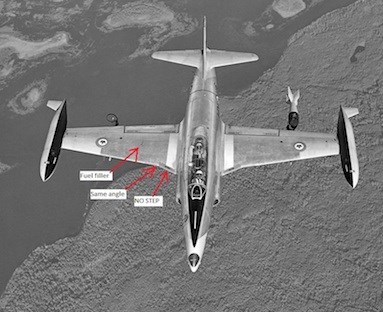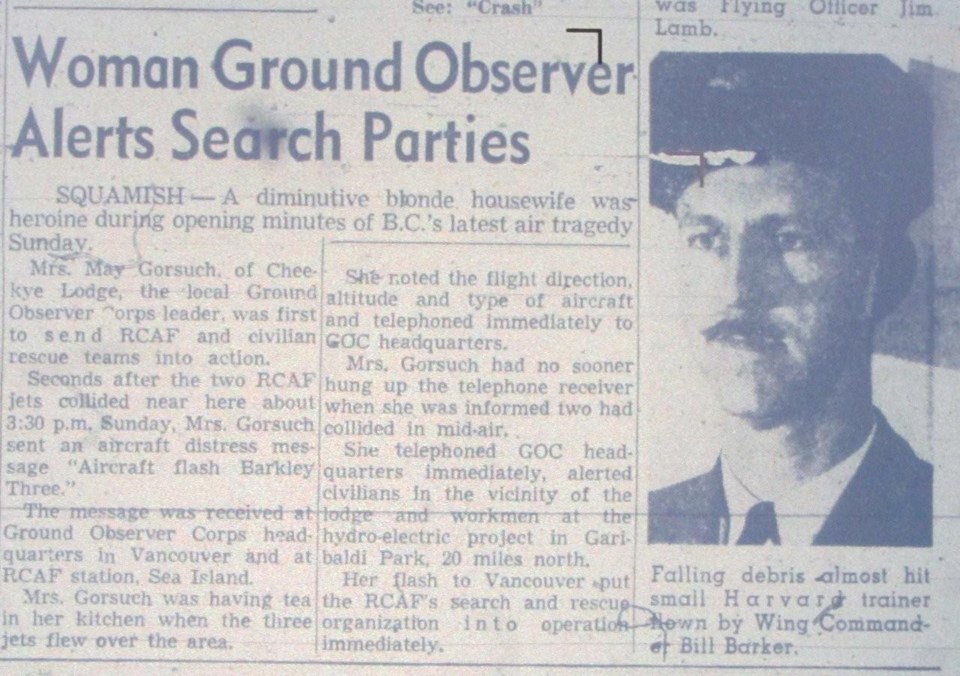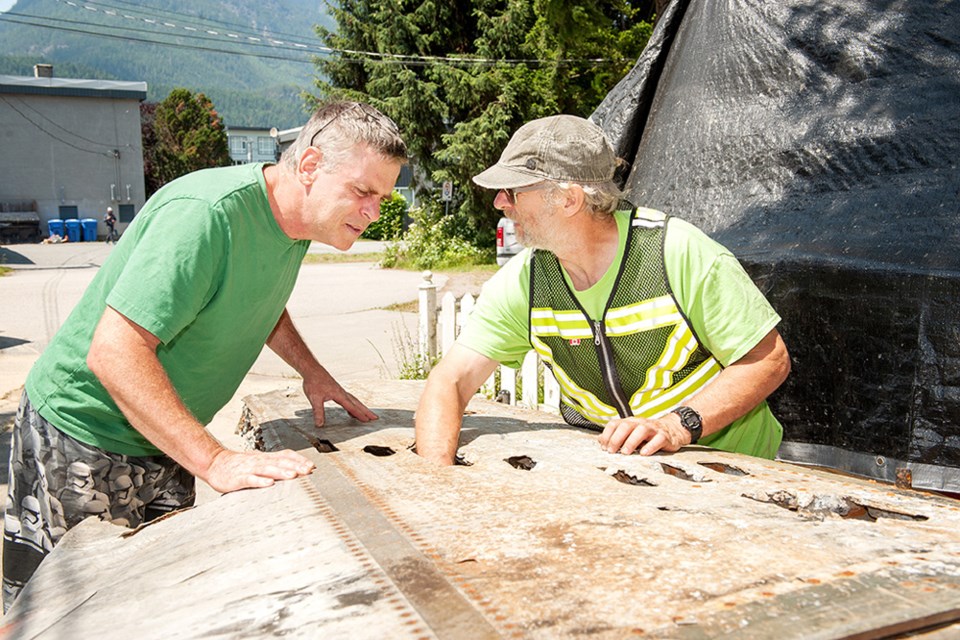The journey to discover the origin of the wing found in a Squamish ditch in mid-June has had as much turbulence as a flight over Howe Sound in a wind storm.
The ending of the story is that the wing is most likely from the fiery, Jan. 13, 1957 mid-air collision of two Royal Canadian Airforce T-33s [aircraft numbers 449 and 460] that happened over the Cheakamus Canyon.
But let’s begin our twisted tale with the uncovering of the wing.
Carl Halvorson, a member of the Squamish Environment Society, was picking up plastic debris on a sunny June morning when he saw a shiny piece of metal sticking out of the ditch. He suspected right away it was a piece of an old plane, he said.
“It was pretty obvious to me,” he said. “It just surprised me it was still there.”
The brush around the gully had been recently cut back, which somewhat exposed the piece.
When Halvorson alerted The Chief of his find, the paper contacted local history-buff John Buchanan who, along with Halvorson, dug the part up.
Only about 20 per cent of the wing was above ground. The rest was deep in the mud. Over two days, the men worked to carefully remove it.
The wing is eight feet long, five feet wide and 12 inches thick.
Buchanan took it home to his yard and painstakingly cleaned off the mud, grass, and debris while documenting each piece in photos. He found a weathered piece of a glass 7-Up bottle, which was a hint that the wing had been underground for a long time, Buchanan said.
From Buchanan’s research online, from a 1954 RCAF, T-33 manual,and old newspaper clippings, he came to believe it is a right wing wheel well, and the right side of the wing section off of a T-33 — a two-person, single-engine jet.
Several such jets crashed in our region in the decades after the Second World War.
The Chief sent Buchanan's photos off to Comox Air Force Museum where it was suggested the wing was likely from the Callaghan Valley crash of the crew of T-33, 21454, that departed from Royal Canadian Air Force Station in Comox mid-morning March 22, 1956 while on what was supposed to be a short, instrument flying practice flight.
Mystery solved, right? No.
As soon as The Chief went public with this suggestion, several people who have been involved with searching for clues to the 1956 crash said it didn’t jive with what they know about the crash,
The size of the intact piece of the wing and the location of the crash imply it isn't from the1957 crash.
How could it get confused? Well, it turns out that unlike today when, after a crash, a wreckage is painstakingly documented, in the 1950s, that wasn’t the case.
And there isn’t an RCAF official today who regularly goes out to identify such old pieces that are uncovered from what are known as legacy sites.
Back in the day, once crashes were investigated and understood, in layman’s terms, they became closed cases, a public affairs officer with 19 Wing Comox explained.
So, bottom line, though after extensive research and interviews it is pretty likely the origin of the wing has been revealed, we may never know beyond a shadow of a doubt that we have the definitive answer.
But why were there so many T-33 crashes in our area?
“They were all finishing their flight either to Comox, or Vancouver or wherever in the day, so were all at the end of their flight, so that is why there’s various wrecks around,” said Don McDonald, the provincial safety officer with PEP Air , an associate member of the Civil Air Search and Rescue Association.
“Statistically, where we find crashed airplanes is in the first and last five per cent of their flight.”
Unlike modern pilots, those flying the T-33 jets in the 1950s didn’t have GPS, and radar coverage wasn’t extensive.
“Not having really good weather knowledge could be a key too and flying very fast — 400 miles plus — so things could happen very quickly,” McDonald said. “When you think of that pre-digital world, there wasn’t a lot…. It is quite amazing they were able to do what they did.”
Buchanan has felt from the start the Squamish wing was from the 1957 crash.

“Other aircraft saw them flying in line 20,000 feet up and about 16 miles north of Squamish. They were doing about 420 miles per hour when they went into a turn,” reads a January 1957 newspaper article in the Vancouver Sun. “‘We can only suppose the leading plane slowed down and or the rear one speeded up and they collided,’” said an RCAF officer in the article at the time. “At that speed, the slightest miscalculation could be fatal.”
Records show two airmen ejected and parachuted to safety — flying officers Bernie McCormack, and Ray Martin.
Flying officers, and fellow UBC students, Burton Patkau, 27, and Roderick Atkins,19, died.
Squamish’s Len Gorsuch, then owner of the Cheekye Lodge, saw the crash happen from his home, according to a newspaper clipping.
“The planes came together… there was a big puff of black smoke, and they fell apart,” Gorsuch told a reporter after the crash.
Thor Halvorson, father of Carl, who found the wing in the ditch, remembers the hubbub in Squamish after the crash.
“A lot of people saw it because in those days if there were jets around, you watched them. They were pretty rare,” Halvorson recalled to The Chief. “There was a fair amount of snow at that time, too.”
The story he heard at the time was that during a maneuver, the canopy of the following aircraft struck the bottom of the leading aircraft’s belly. That caused the lead aircraft — that carried McCormack and Miller — to burst into flame and they ejected.
The following plane spun out of control and crashed.

Records for search and rescue file #175 from the Comox museum show that one aircraft was found approximately 200 feet to the left of the road, alongside Cheakamus River. The second aircraft was initially found up the ridge from the river’s edge.
“The 1957 Cheakamus crash made more sense,” said Buchanan. “The crash site was more accessible [than the 1956 site], pieces of the plane even fell into the river,” Buchanan said. “One piece of wreckage was noted in the Vancouver Sun Jan. 14,1957 [story]. It was a piece of the wing about six feet long, 500 feet away from the railway line. Likely this piece of the wing was eventually loaded onto a railcar along with other wreckage and while being transported south it fell off and into the ditch, and remained untouched for 61 years until Carl Halvorson stumbled across it.”
Other pilots and aviation enthusiasts have chimed in on this wing, and most seem to agree the 1957 crash is the likeliest conclusion.
Given the co-ordinates of the 1957 crash, Buchanan hiked in this week with his metal detector and found one of the crash sites at the very northern end of Paradise Valley next to the railway.
“Two planes, one on the West side of the river one on the East. I found the one on the East side,” he explained.
Buchanan says after visiting the hard-to-reach location, he is even more convinced he has the wing from that crash.
“Since this site is located next to the railway line, and that it is also clear the site was mostly removed in 1957, and would have been by rail, it leaves no doubt in my mind that the wing that Carl found is from the same plane. It merely fell off the train as it was passing by,” he said.



